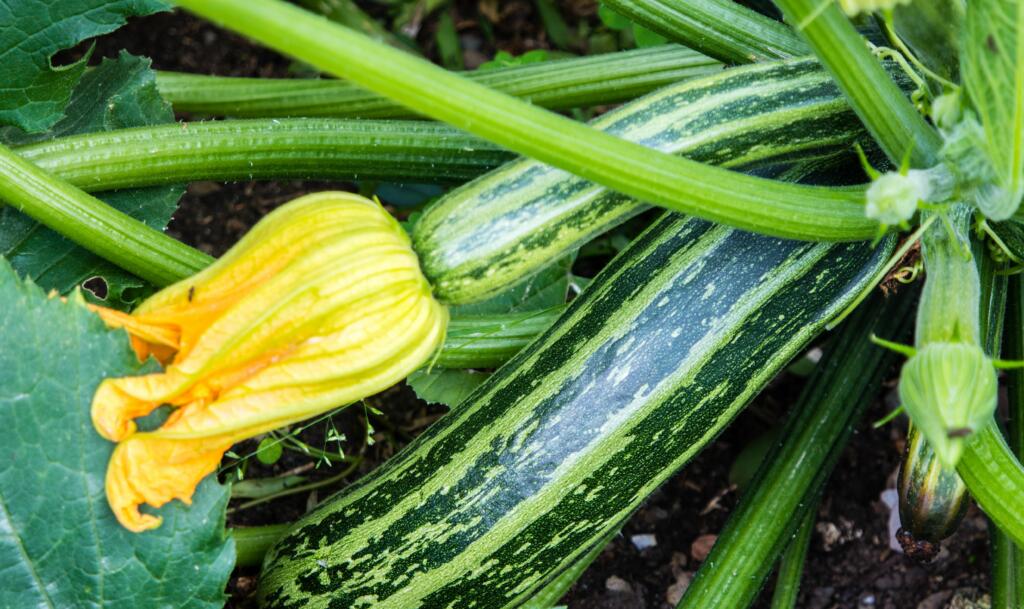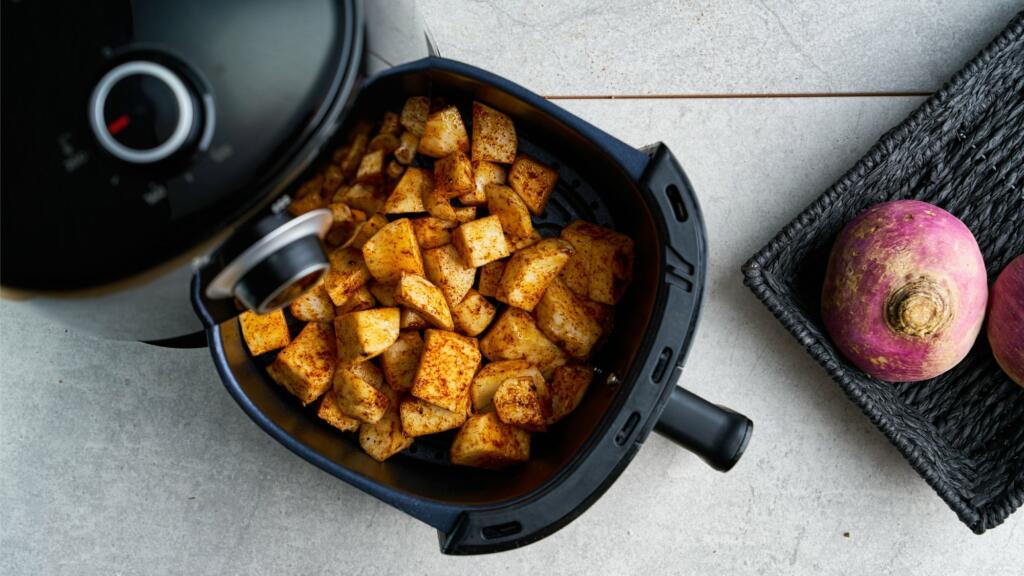
When and how to harvest rhubarb, with tips from Monty Don
Amy Cutmore
Learn how to cultivate these easy and delicious vegetables for a bumper crop.
Keen to grow your own crops and taste the fruits of your labour? Courgettes – sometimes known as zucchini – are one of the most popular vegetables to grow and will bear an abundant harvest that can be enjoyed in in all kinds of dishes from June through to October.
Keen to grow your own crops and taste the fruits of your labour? Courgettes – sometimes known as zucchini – are one of the most popular vegetables to grow and will bear an abundant harvest that can be enjoyed in in all kinds of dishes from June through to October.
 Credit: Shutterstock / Animaflora PicsStock
Credit: Shutterstock / Animaflora PicsStockKnowing how to grow courgettes and when to plant them out will guarantee a plentiful and healthy harvest through the summer and into autumn. Saga Exceptional spoke to Olivia Steed-Mundin, kitchen gardener at the National Trust’s Sissinghurst Castle Garden, for her top tips on growing courgettes.
The vegetable garden at Sissinghurst was created in 2008 and is based on organic principles. It also uses the eco-friendly “no dig” method.
When choosing what type to grow, Steed-Mundin particularly likes some Italian varieties: “Romanesco crops really well, and it has a lovely flavour and nutty texture, and Genovese is a light-coloured green courgette, and it starts to fruit quite early.”
There are lots of courgette varieties to choose from, including trailing plants if you have plenty of space, or compact plants better suited to small gardens or containers.
For those living in southern England, mid-April is a good time to sow courgette seeds indoors. “This gives you a good four to five weeks for them to mature, so they’ll be ready to plant in your vegetable garden in the middle of May, when the risk of frost has passed,” advises Steed-Mundin.
However, if you live further north she suggests waiting a few more weeks so that your garden can catch up with the warmer climate.
Courgette planting timeline
Sow – April, May, June
Plant out – May to June
Harvest – June, July August, September, October
It’s best to use a 9cm (3.5in) pot to plant your seeds. “It will seem like a relatively big pot, says Steed-Mundin, “but when the seeds germinate, the plants get big quite quickly.”
She recommends filling up the pot to the top with compost: “At the National Trust, we’d always recommend using a peat-free compost, or ideally a seed compost. But courgettes are pretty good germinator, so a multi-purpose compost would be fine too.”
Next, create a 1.5cm (0.5in) hole in the centre of the pot, and insert one seed, covering it with the compost. Once you’ve sown the seeds, place the pots in a greenhouse – Steed-Mundin explains that it doesn’t have to be heated this time of year. Alternatively, you could place your seedlings on a south-facing windowsill in your house, or even outside against a south-facing wall.
Starting off inside or outside: which is best?
It’s better to sow courgette seeds indoors rather than outside, as they have more chance of germination and won’t get attacked by slugs or snails. However, if you do sow the seeds outside, Steed-Mundin advises: “Wait until May and sow them under a cloche to create a higher temperature to aid germination.” And expect them to be ready a month later than indoor sown seeds.”
Once you’ve sown your seeds, you’ll be eager for them to germinate and grow into small seedlings. For this to happen, Steed-Mudin recommends keeping your pots at a steady temperature of around 15°C to 20°C (59°F to 68°F).
“Pop them in a propagator with an open vent and as soon as they germinate, take the lid off as the heat can get too intense,” she advises.
Germination time will depend on the level of warmth, but if the pots are indoors or in a greenhouse, you’re looking at seven to 10 days. Otherwise, expect them to take 10-14 days. Once they’ve germinated, leave them in the seedling pots until they start to develop four or five leaves, at which point they are ready for transplanting.
 Credit: Shutterstock/J Davidson
Credit: Shutterstock/J DavidsonHardening off your plants
Before transplanting your plants into your vegetable garden, it’s worth acclimatising them to the cooler outside temperatures. You can do this by taking them outside in the daytime and bringing them back inside in the evening. Alternatively, you could place them in a cold frame for a week.
Your small plants will be ready to put outside around the middle of May, although Steed-Mundin warns that it’s important to keep on top of weather conditions: “If there’s still a chance of frost, wait a little longer.”
When the conditions are right, she recommends preparing the soil: “Get rid of the weeds, level off the soil so it’s nice and even, and if you have heavy clay soil, add some mulch to loosen it up. Then space the plants 90cm apart – this gives them space to mature and also helps reduce the risk of powdery mildew.”
It’s worth checking the courgette variety you are growing, as trailing varieties may need to be planted up to 1.2m (4ft) apart.
“If you’re in a cooler area, put a plastic cloche over the plants when you first put them out, it can help to bring them on in the early part of the season,” she adds. Make sure there’s a ventilation hole in the cloche to prevent the plant from dying.
Can courgettes be grown in containers?
Courgettes can be grown in containers, but you’ll need a big pot – 40-50 litres (911 galons). However, Steed–Mundin warns: “They are harder to look after as they will need watering every day and you’ll need to feed them.”
“Courgettes are a good plant for beginners as they don’t need much looking after, other than watering. However, when you first plant them they need watering two to three times a week,” says Steed-Mundin.
And be sure when you water them to give them a good soaking to get down to the roots. Once the plants are established you shouldn’t have to water as often, but it will depend on the weather conditions.
“A good water-saving tip is to plant them out with a slight well around the plant base so that water stays around the roots. And mulching will help water retention within the soil,” she adds.
Courgettes are unlikely to need feeding unless you’ve got poor soil, or you’re growning them in pots, but if this is the case, Steed-Mundin recommends using an organic feed, such as Maxicrop’s Tomato Liquid Organic fertiliser, available from B&Q at £10.95.
Courgettes are prone to getting powdery mildew. It’s a common fungal disease that covers the surface of a plant. It appears as light grey or powdery spots on leaves, although it can also be found on plant stems, flowers, fruits or vegetables. It is worse when plants are stressed. The disease thrives in the kind of mild conditions we experience during late spring and early summer. Lack of sunlight and poor air circulation around the plant can encourage powdery mildew.
Steed-Mundin says you’re likely to experience some powdery mildew even if you take preventative steps to keep it at bay. She advises: “Space your plants well and remove any old leaves to help with air circulation, and make sure they are well mulched to retain water.”
 Credit: Shutterstock/KanphotoSS
Credit: Shutterstock/KanphotoSSHere comes the fun bit: harvesting your homegrown crop of courgette.! When you pick them will depend on the variety, but for the Italian varieties, Romanesco and Genovese, are ideal when they reach between 15cm-20cm (6in-8in). “I like to pick them when small because they are much nicer to eat. When you leave them to get bigger, they contain more water and are not as tasty,” explains Steed-Mundin. Make sure you keep picking, otherwise you’ll end up with marrows, which will also cause the plant to stop producing new courgettes.
You can expect to start harvesting your crop three to four weeks after planting, and your heaviest crop will be between mid-June and the end of August. The crop will begin to peter out in September and finish at the end of October. If you live in the north, your final harvest will be a little earlier.
 Credit: Shutterstock/Aksana Yasiuchenia
Credit: Shutterstock/Aksana YasiucheniaEnjoying the fruits of your labour
Courgettes can be enjoyed in many recipes, but Steed-Mundin enjoys hers with pasta. “My favourite is lightly cooking thin slivers of courgettes with lots of herbs and oil.”
The flowers can also be eaten – if you want to eat the courgette with flower attached, pick the courgette when small at around 8cm-10cm (3in-4in). You can also pick and eat the male flowers that don’t have courgettes attached.“I enjoy them cooked in the oven, filled with ricotta cheese, tomatoes, herbs and lemon zest,” she adds.

Written by Camilla Sharman she/her
Published: Updated:
With her 30 years of experience, Camilla Sharman has covered a wide range of sectors within the business and consumer industries both as a feature, content, and freelance writer. As a business journalist, Camilla has researched articles for many different sectors from the jewellery industry to finance and tech, charities, and the arts. Whatever she’s covered, she enjoys delving deep and learning the ins and out of different topics, then conveying her research within engaging content that informs the reader.

Amy Cutmore

Rhoda Parry

Rosanna Spence

Gemma Harris